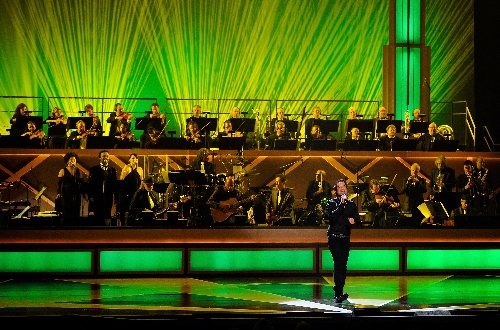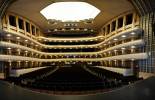Hall designed with ear for quiet detail
Planes, trains and highway noise are bearable sounds of everyday life, unless they come during the delicate second movement of Mahler's "Resurrection" symphony.
Outside intrusions are forgivable in cities where the concert hall came first and the interstate freeway second, but not when it's the other way around. So while it was incumbent, even expected, for The Smith Center to sport the latest in sound-design technology, its location on the old Union Pacific rail yard called for an old-fashioned solution.
Concrete. Lots of it.
A comprehensive site noise and vibration survey determined that nearby Interstate 15 and Hoover Dam-bound tourist helicopters were easier to deal with than the ground vibrations from still-active portions of the railroad track.
The solution turned out to be "a very heavy slab at the base of the auditorium and the stage," says Paul Scarbrough, the project's acoustic designer. "And by 'very heavy,' I mean a solid concrete slab that's 3 feet thick. That would stiffen the foundation sufficiently and provide enough of a barrier to that vibration that it wouldn't create audible noise in the auditorium."
Smith Center officials like to tout the fact that Akustics, Scarbrough's South Norwalk, Conn., firm, was the first designer hired for the project in 2006, slightly ahead of even the architect.
That said, "It's not often we're called in after the fact anymore," Scarbrough says. His firm also worked with architect David Schwarz on the Schermerhorn Symphony Center that opened in Nashville, Tenn., in 2006, just as The Smith Center project was getting started.
Acoustics is "half science and half art," says the center's president, Myron Martin. "We spent a lot of time at Carnegie Hall," which is known for its acoustics. "We took it really seriously. It was aspirational. We weren't going to settle for anything less than great."
"The thing that we wanted to grasp from those older halls was the wonderful sense of intimacy that they often have," Scarbrough adds. "The real sense that the room, no matter what the seating capacity is, feels quite intimate and quite connected to the performer onstage."
The big difference between The Smith Center and the Schermerhorn is that the latter is a dedicated symphonic hall, while Broadway tours go to a different venue, the Tennessee Performing Arts Center.
"Twenty years ago, people would say that a multipurpose hall is a no-purpose hall, because you can't do both really well," Martin says. "Once upon a time you just couldn't. Today you can, and there are a number of good examples. The one we kept going back to was Bass (Performance) Hall," the Fort Worth, Texas, facility also designed by Schwarz.
In a new, ground-up project, it's hard to separate design issues from sound issues. The seating capacity, for instance, is central to the acoustics. To get much larger than Reynolds Hall's 2,050 seats, "little things suffer, and you have to start to make trade-offs. Maybe the last two rows don't have as strong a connection to the rest of the room."
The devil is even in details such as the carpet. Martin pushed for carpeting in Reynolds Hall's aisles and box seats, which would make moving the chairs quieter. But "I couldn't win," he says, because the experts said "a little bit of carpet can change the acoustics."
Even the air conditioning is an acoustical issue as well as a mechanical one. You don't want the audience to hear blowers kick in during the middle of a violin solo. In an older building, cold air is piped in from the roof to filter down and pick up heat as it falls.
Here, a displacement system delivers air from the floor, and the air is "delivered very, very slowly so it's essentially silent," Scarbrough says.
Reynolds Hall is designed to give each touring Broadway show the choice of moving the house speakers out of the way and loading in their own (should they feel that's really necessary), augmenting the house system with their own gear or simply walking in with a flash drive to download the cues for a "plug and play" option.
Retractable draperies come into play to provide absorptive material for amplified performances. Motorized doors on side walls open vestibules to allow sound to bleed off without echo.
But the real test of a state-of-the-art venue is how it sounds for its most delicate uses: unamplified orchestral, dance and opera performances. "The basic natural acoustics of the room are tailored for symphonic music," Scarbrough says, including the height of the ceiling, width of the side walls and the cubic volume of the room.
For orchestras and other unamplified performances, a shell lowers to the stage to create a chamber that "makes the theater into a concert hall by making the stage a responsive environment for musicians."
The opera house design uses the overhanging balconies on the side and rear walls to "direct what we call early reflected energy to the orchestra floor," creating an immersive sound "coming from the stage and from all around you."
The real moment of truth comes on March 24, when the Las Vegas Philharmonic plays the "Resurrection" symphony. But from early tests onstage with the orchestra, the hall's sound "seems to be responding very much in line with what our modeling and gut instincts told us," Scarbrough says. "The room is very resonant, very present, and you feel very connected to the performers onstage."
And if that's the case, you will remember to turn off your cellphone.
Contact reporter Mike Weatherford at
mweatherford@reviewjournal.com or 702-383-0288.





























